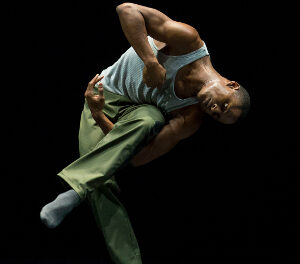Beyond the obsessive, all-pervasive UNC-Duke basketball rivalry, there seems to be another — and somewhat more exalted — competition between these two great institutions. Together, these universities present performing arts series that rival those anywhere, and I mean New York, Los Angeles, London, Paris or any other major artistic center. Tonight it was UNC-Chapel Hill’s Carolina Performing Arts presenting the Alvin Ailey American Dance Theater, one of the great success stories in the history of dance.
Beginning in 1958 in what is now the 92nd Street “Y” in New York City, the-seven person African-American dance ensemble took the dance world by storm and in just a few years was representing the United States in tours all over the world. Alvin Ailey, founder, director, choreographer and principle dancer, eventually opened the company as a multi-cultural/racial ensemble, expanded the number of dancers, and became the leading proponent of modern dance in the world. The current company, with Robert Battle, Artistic Director, and Masazumi Chaya, Associate Artistic Director, now boasts over thirty dancers. Although all of the names were printed in the program, there was quite a lengthy announcement of numerous substitutions before the dances began.
One of the many great aspects of attending an Alvin Ailey dance concert is their mixture of newly choreographed works with some of their “greatest hits.” Tonight was no exception as they began with “Another Night,” a 2012 work choreographed by Kyle Abraham. As is always the case with this ensemble, the choice of music seems almost inevitable, and so it was with Art Blakey & The Jazz Messengers’ recording of the Dizzy Gillespie classic “A Night in Tunisia.” This slowly built with the appearance of a lone female dancer bathed in a beautiful blue light expressing the building rhythms. Eventually ten dancers would take the stage in a propulsive, energetic piece perfectly mimicking Dizzy’s music. The trademark athleticism and seemingly effortless ability to push their bodies to the limits was evident throughout.
The next work, “Pas De Duke” is from 1976 and significant on many levels. This is a modern dance interpretation of classical ballet’s pas de deux and created for Judith Jamison, former artistic director of the company, and Mikhail Baryshnikov. Based on the music of Duke Ellington, this featured dancers Alicia Graf Mack and Kirven James Boyd in alternating duo and solo segments. As the name implies, this work is a thrilling combination of classical, modern, jazz, and gymnastic moves that each dancer executed with remarkable technique, spirit, and joy. Especially revealing was the dancers’ ability to physically communicate the dance equivalent of jazz improvisation.
While there was ample notice that there would be two fifteen-minute intermissions, it was just a minute or two before the exiting audience realized that there was something going on in front of the curtain in preparation for the thoroughly mind-blowing Minus 16. A lone dancer in a black business suit was presenting a somewhat comical solo prior to, and leading into Ohad Naharin’s spectacular 1999 Minus 16, an international smorgasbord of music ranging from traditional Israeli music to techno to Dean Martin to Vivaldi to “Somewhere Over the Rainbow.” When the curtain rose, there were twenty dancers dressed like the soloist, all sitting in chairs in a large semi-circle. Every few minutes they would thrust out their white-shirted chests in a quasi-stadium wave, except for the last dancer on the right who would fall to the floor. What does that mean? Whatever you want it to. This was only the beginning. When all the dancers exited the stage and walked up the aisles, it spiked my anxiety to a life-threatening level as I knew the dreaded audience participation was coming and I was seated on the aisle. What happened was quite remarkable. Random audience members were plucked from the theater and, amazingly, each proceeded to actually perform — most quite well — with each dancer.
A major reason for the then fledgling Alvin Ailey American Dance Theater’s ascendance to the apex of the modern dance world was their 1960 Revelations choreographed by Alvin Ailey to the music of traditional spirituals. Since that time more than fifty years ago, Revelations has become the most seen modern dance work in history and it is certainly no mystery why that is. This nearly 40-minute masterpiece is divided into three sections: “Pilgrim of Sorrows,” “Take Me to the Water,” and “Move, Members, Move.” Each one contained three or four of the most beautifully uplifting spirituals you’ve ever heard. There is great variety both in the number of dancers and the tone of the music, ranging from quiet introspection to buoyant jubilation. As exciting as the full company numbers were, I found the most affecting and emotionally compelling were the smaller, more intimate works like the duo “Fix Me, Jesus” and especially Guillermo Asca’s haunting solo to “I Wanna Be Ready.” But perhaps the iconic section, for the music, dance and costumes, is the finale “Rocka My Soul in the Bosom of Abraham.” Women in white summer dresses and parasols partnered with elegantly dressed men, rejoice in what may be as good a concept of heaven ever portrayed.












